| Topic: DRAGONS UNICORNS MERMAIDS PEGASUS OTHER MYTHIC ANIMALS | |
|---|---|
|
Edited by
tazzops
on
Sun 08/21/11 07:44 AM
|
|


The Red Panda, Ailurus fulgens ("shining cat," from a Latinized form of the Greek, ailouros, "cat," and the participial form of the Latin fulgere, "to shine") is a mostly herbivorous mammal, slightly larger than a domestic cat (55 cm long). The Red Panda has semi-retractile claws and, like the Giant Panda, has a "false thumb" which is really an extension of the wrist bone. Thick fur on the soles of the feet offers protection from cold and hides scent glands. The Red Panda is native to the Himalayas in Nepal and southern China. The word panda is derived from Nepalese word "ponya" which means bamboo and plants eating animals in Nepal. |
|
|
|
|
|
Edited by
tazzops
on
Sun 08/21/11 07:51 AM
|
|
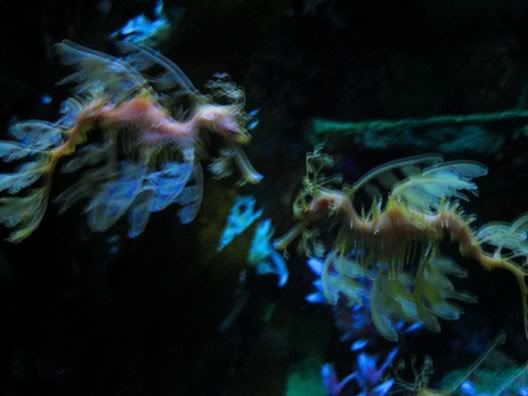
Named after the dragons of Chinese mythology, Leafy seadragons (Phycodurus eques) resemble a piece of drifting seaweed as they float in the seaweed-filled water. The Leafy seadragon, with green, orange and gold hues along its body, is covered with leaf-like appendages, making it remarkably camouflaged. Only the fluttering of tiny fins or the moving of an independently swiveling eye, reveals its presence. Like the seahorse, the male seadragon carries as many as 150-200 eggs. After being deposited by the female, the eggs are carried in the honeycomb-shaped area (known as the brood patch) under the male's tail for approximately eight weeks. Seadragons have no teeth or stomach and feed exclusively on mysidopsis shrimp. Known as "Australian seahorses" in Australia, they are found in calm, cold water that is approximately 50-54° F (10-12° C). Leafy seadragons have been protected by the South Australian government since 1982. |
|
|
|
|
|
Edited by
tazzops
on
Sun 08/21/11 07:56 AM
|
|

The Platypus (Ornithorhynchus anatinus) is a semi-aquatic mammal endemic to eastern Australia, including Tasmania. Together with the four species of echidna, it is one of the five extant species of monotremes, the only mammals that lay eggs instead of giving birth to live young. It is the sole living representative of its family (Ornithorhynchidae) and genus (Ornithorhynchus), though a number of related species have been found in the fossil record. The bizarre appearance of this egg-laying, duck-billed mammal baffled naturalists when it was first discovered, with some considering it an elaborate fraud. It is one of the few venomous mammals; the male Platypus has a spur on the hind foot which delivers a poison capable of causing severe pain to humans. The unique features of the Platypus make it an important subject in the study of evolutionary biology and a recognizable and iconic symbol of Australia; it has appeared as a mascot at national events and is featured on the reverse of the Australian 20 cent coin. Until the early 20th century it was hunted for its fur, but it is now protected throughout its range. Although captive breeding programs have had only limited success and the Platypus is vulnerable to the effects of pollution, it is not under any immediate threat. |
|
|
|
|
|
Edited by
tazzops
on
Sun 08/21/11 08:09 AM
|
|
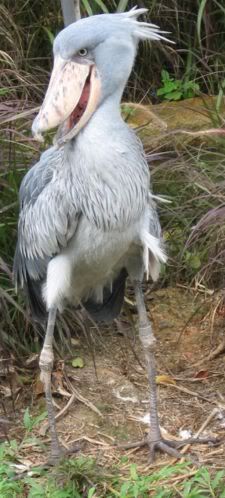
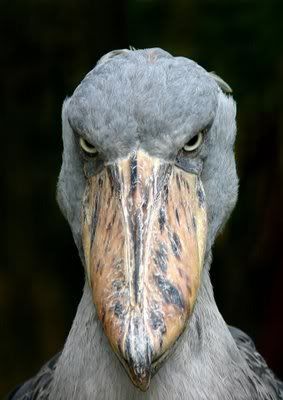
The Shoebill, Balaeniceps rex also known as Whalehead is a very large bird related to the storks. It derives its name from its massive shoe-shaped bill. The Shoebill is a very large bird, averaging 1.2 m (4 ft) tall, 5.6 kg (12.3 lbs) and 2.33 m (7.7 ft) across the wings. The adult is mainly grey, the juveniles are browner. It lives in tropical east Africa, in large swamps from Sudan to Zambia. The Shoebill was added rather recently to the ornithological lists; the species was only discovered in the 19th century when some skins were brought to Europe. It was not until years later that live specimens reached the scientific community. The bird was known to both ancient Egyptians and Arabs however. There exist Egyptian images depicting the Shoebill while the Arabs referred to the bird as abu markub, which means one with a shoe. Clearly, this refers to the striking bill. |
|
|
|
|
|
Edited by
tazzops
on
Sun 08/21/11 08:11 AM
|
|
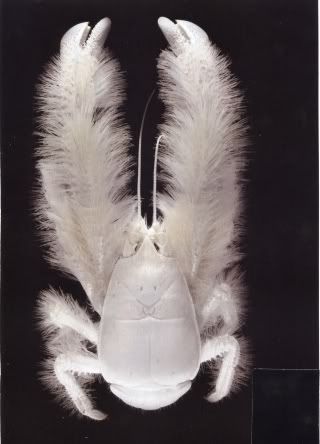
Kiwa hirsuta is a crustacean discovered in 2005 in the South Pacific Ocean. This decapod, which is approximately 15 cm (6 inches) long, is notable for the quantity of silky blond setae (resembling fur) covering its pereiopods (thoracic legs, including claws). Its discoverers dubbed it the "yeti lobster" or "yeti crab"[2]. K. hirsuta was discovered in March 2005 by a group organised by Robert Vrijenhoek of the Monterey Bay Aquarium Research Institute in Monterey, California, using the submarine DSV Alvin, operating from RV Atlantis[3]. The discovery was announced on the 7th of March, 2006. It was found 1,500 km (900 miles) south of Easter Island in the South Pacific, at a depth of 2,200 m (7,200 feet), living on hydrothermal vents along the Pacific-Antarctic Ridge[4]. Based on both morphology and molecular data, the species was deemed to form a new genus and family (Kiwaidae). The animal has strongly reduced eyes that lack pigment, and is thought to be blind. The 'hairy' pincers contain filamentous bacteria, which the creature may use to detoxify poisonous minerals from the water emitted by the hydrothermal vents where it lives. Alternatively, it may feed on the bacteria, although it is thought to be a general carnivore[2]. Its diet also consists of green algae and small shrimp. |
|
|
|
|
|
Edited by
tazzops
on
Sun 08/21/11 09:36 AM
|
|
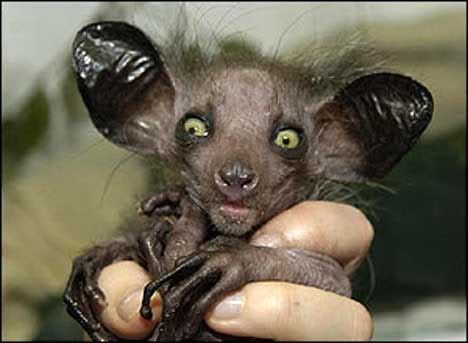
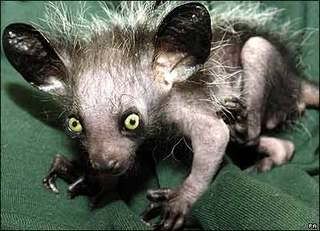
The Aye-aye (Daubentonia madagascariensis) is a strepsirrhine native to Madagascar that combines rodent-like teeth with a long, thin middle finger to fill the same ecological niche as a woodpecker. It is the world's largest nocturnal primate, and is characterized by its unique method of finding food; it taps on trees to find grubs, then gnaws holes in the wood and inserts its elongated middle finger to pull the grubs out. Daubentonia is the only genus in the family Daubentoniidae and infraorder Chiromyiformes. The Aye-aye is the only extant member of the genus (although it is currently an endangered species); a second species (Daubentonia robusta) was exterminated over the last few centuries. Also the offspring of Roberta and Ujgearhead, a computer imaging of her and Ujgearheads face, together, to see what their baby would look like. Stranger than fiction indeed. |
|
|
|
|


The Aye-aye (Daubentonia madagascariensis) is a strepsirrhine native to Madagascar that combines rodent-like teeth with a long, thin middle finger to fill the same ecological niche as a woodpecker. It is the world's largest nocturnal primate, and is characterized by its unique method of finding food; it taps on trees to find grubs, then gnaws holes in the wood and inserts its elongated middle finger to pull the grubs out. Daubentonia is the only genus in the family Daubentoniidae and infraorder Chiromyiformes. The Aye-aye is the only extant member of the genus (although it is currently an endangered species); a second species (Daubentonia robusta) was exterminated over the last few centuries. Also the offspring of Roberta and Ujgearhead, a computer imaging of her and Ujgearheads face, together, to see what their baby would look like. Stranger than fiction indeed.       
|
|
|
|
|
                                               
|
|
|
|
|


The Red Panda, Ailurus fulgens ("shining cat," from a Latinized form of the Greek, ailouros, "cat," and the participial form of the Latin fulgere, "to shine") is a mostly herbivorous mammal, slightly larger than a domestic cat (55 cm long). The Red Panda has semi-retractile claws and, like the Giant Panda, has a "false thumb" which is really an extension of the wrist bone. Thick fur on the soles of the feet offers protection from cold and hides scent glands. The Red Panda is native to the Himalayas in Nepal and southern China. The word panda is derived from Nepalese word "ponya" which means bamboo and plants eating animals in Nepal.          My favorite I love Red Pandas they are so adorable. My favorite I love Red Pandas they are so adorable.   
|
|
|
|
|
|
They are cute are they not.
  
|
|
|
|
|
|
They look so cuddly and adorable but I know they are a wild animal, I wonder if there is still many left in the world, I will do some reasearch on that.

|
|
|
|
|
|
Edited by
tazzops
on
Sun 08/21/11 03:16 PM
|
|
|
They look like they could be a house pet.
A little more information. The red panda is dwarfed by the black-and-white giant that shares its name. These pandas typically grow to the size of a house cat, though their big, bushy tails add an additional 18 inches (46 centimeters). The pandas use their ringed tails as wraparound blankets in the chilly mountain heights. The red panda shares the giant panda's rainy, high-altitude forest habitat, but has a wider range. Red pandas live in the mountains of Nepal and northern Myanmar (Burma), as well as in central China. These animals spend most of their lives in trees and even sleep aloft. When foraging, they are most active at night as well as in the gloaming hours of dusk and dawn. Red pandas have a taste for bamboo but, unlike their larger relatives, they eat many other foods as well—fruit, acorns, roots, and eggs. Like giant pandas, they have an extended wrist bone that functions almost like a thumb and greatly aids their grip. They are shy and solitary except when mating. Females give birth in the spring and summer, typically to one to four young. Young red pandas remain in their nests for about 90 days, during which time their mother cares for them. (Males take little or no interest in their offspring.) The red panda has given scientists taxonomic fits. It has been classified as a relative of the giant panda, and also of the raccoon, with which it shares a ringed tail. Currently, red pandas are considered members of their own unique family—the Ailuridae. Red pandas are endangered, victims of deforestation. Their natural space is shrinking as more and more forests are destroyed by logging and the spread of agriculture. Conservation: Red pandas are listed as vulnerable on the IUCN Red List of Threatened Species because of habitat loss. There are fewer than 2,500 adult red pandas. |
|
|
|
|
|
Edited by
tazzops
on
Sun 08/21/11 03:26 PM
|
|

Disheveled in appearance, the sloth bear leads a reclusive life in India's forests, noisily seeking out insects and fruits. Physical Description: Sloth bears have shaggy, dusty-black coats, pale, short-haired muzzles, and long, curved claws that they use to excavate ants and termites. A cream-colored "V" or "Y" usually marks their chests. Sloth bears' nostrils can close, protecting the animals from dust or insects when raiding termite nests or bee hives. A gap in their teeth enables them to suck up ants, termites, and other insects. Size: Sloth bears grow five to six feet long, stand two to three feet high at the shoulder, and weigh from 120 (in lighter females) to 310 pounds (in heavy males). Geographic Distribution: Most sloth bears live in India and Sri Lanka; others live in southern Nepal, and they have been reported in Bhutan and Bangladesh. Status: The sloth bear is listed as vulnerable on the World Conservation Union's Red List of Threatened Animals. Habitat: Sloth bears live in a variety of dry and wet forests, and also in some grasslands, where boulders and scattered shrubs and trees provide shelter. Natural Diet: When trees are in fruit, usually during the monsoon season, sloth bears dine on mango, fig, ebony, and other fruits, and also on some flowers. However, ants and termites, dug out of their cement-hard nest mounds, are a year-round staple. Also, sloth bears climb trees and knock down honeycombs, later collecting the sweet bounty on the forest floor. Beetles, grubs, ants, and other insects round out their diet. During food shortages, sloth bears will eat carrion. They sometimes raid farm crops. Zoo Diet: The Zoo's sloth bears eat insects, mealworms, and crickets, as well as such fruits as pears, melons, oranges, and grapes. Reproduction: Sloth bears mate during the hot season—May, June, and July—and females usually give birth to two cubs six to seven months later. Cubs are born in an underground den, and stay there for several months. After emerging from the den, cubs stay at their mother's side for two to three years before heading off on their own. Behavior: Active mostly at night, the sloth bear is a noisy, busy bear. It grunts and snorts as it pulls down branches to get fruit, digs for termites, or snuffles under debris for grubs and beetles. A sloth bear uses its lips like a vacuum, making rapid, loud "kerfump" noises as it sucks insects from their nests. Sloth bears lead solitary lives, and most are nocturnal. (In protected areas, they may be active during the day.) If threatened, these smallish bears will stand on two legs, brandishing their clawed forepaws as weapons. A Few Sloth Bear Neighbors: Bengal tiger (Panthera tigris tigris): At the top of the forest food chain, this mighty, endangered cat slinks through the shadows in search of spotted deer and other prey, which sometimes includes sloth bears. Gaur (Bos frontalis): A massive, forest-dwelling wild ox that lives in small herds and feeds in clearings at night. Lion-tailed macaque (Macaca silenus): An endangered, black-coated monkey with a distinctive gray mane and dangling tail. Troops of 12 to 20 inhabit tropical evergreen forests in India's Western Ghats mountains. Great pied hornbill (Buceros bicornis): A vulture-sized black, white, and cream-colored fruit-eating bird with a massive, toucan-like bill. Fun Facts: Sloth bears are the only bears to carry young on their backs. In the late 1700s, the first Europeans to see sloth bears described them as bear-like sloths due to their ungainly appearance and long claws. The Hindi word for bear—bhalu—inspired the name of Rudyard Kipling's bear character Baloo in The Jungle Book. |
|
|
|
|
|
Edited by
tazzops
on
Sun 08/21/11 03:29 PM
|
|
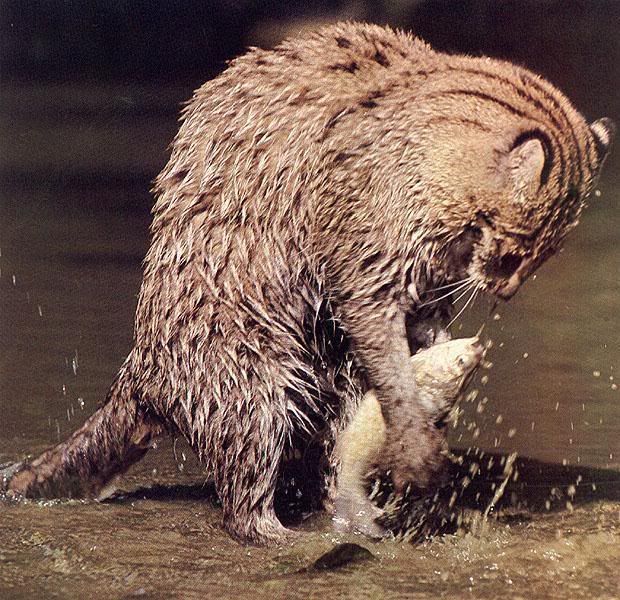
Order: Carnivora Family: Felidae Genus and Species: Prionailurus viverrinus Description: Fishing cats range from about 25 pounds for males to about 15 pounds for females. Head and body length is 25 to 34 inches. These cats have a long, stocky body, relatively short legs, a broad head, round ears, and a short tail. Their olive-gray fur has black stripes and rows of black spots. Distribution and Habitat: The fishing cat’s general distribution is southwest India, Sri Lanka, countries of the southern Himalayas, Bangladesh, Vietnam, Thailand, Burma, China, and the Indonesian islands of Java and Sumatra. However, these cats are not found all throughout this broad area because of their habitat preferences. They are strongly tied to densely vegetated areas near water, in marshes, mangroves, rivers, and streams. Diet: The fishing cat’s diet includes birds, small mammals, snakes, snails, and fish. The cat attracts fish by lightly tapping the water's surface with its paw, mimicking insect movements. Then, it dives into the water to catch the fish. It can also use its partially webbed paws to scoop fish, frogs, and other prey out of the water or swim underwater to prey on ducks and other aquatic birds. It is powerful enough to take large prey, such as calves and dogs. Reproduction: Two to three young are born after a gestation of about 63 days. Young reach adult size at less than one year of age. Little is known about the details of their reproductive or social behavior in the wild. Conservation: Fishing cats are are listed as endangered on the IUCN's Red List of Threatened Species. They are threatened by habitat loss and hunting for food and fur. People have drained many wetland areas to make room for farmland and roads. Pollution from industries has poisoned rivers and streams where fishing cats once fed. However, fishing cats appear to do well in suburban habitats, so they may prove adaptable to human activities that some other species. Fun Facts When swimming, the fishing cat may use its short, flattened tail like a rudder, helping control its direction in the water. Part of the fishing cat's scientific name, viverrinus, comes from the taxonomic family Viverridae. Like the fishing cat, civets and other members of this group have long bodies and short legs, and many have stripes or spots along the body, and banded tails. |
|
|
|
|
|
Edited by
tazzops
on
Sun 08/21/11 03:39 PM
|
|

Description: Clouded leopards typically weigh about 28 pounds and are about 36 inches long (not including the tail, which is usually 30 inches long). Their fur ranges from pale yellow to brown with darker cloud-like markings. They have relatively short legs and large paws. Clouded leopards' long tails help them balance on narrow branches and jump safely from tree to tree. Watch a video Distribution and Habitat: This species of clouded leopard ranges from countries of the Himalayas, southern China, and Taiwan to peninsula Malaysia. In 2006, scientists determined that the clouded leopards living on the islands of Sumatra and Borneo are a distinct species, Neofelis diardi. See Clouded Leopard Times Two. Rarely seen in the wild, there is some controversy as to whether the clouded leopard is an arboreal species—strongly tied to dense tropical evergreen forest—or a terrestrial hunter that uses roads and trails in logged forests. The answer is probably somewhere in between—the clouded leopard can hunt both in trees and on the ground. These cats can also live in drier forests if there is suitable prey. Diet: The clouded leopard’s diet includes birds, monkeys, pigs, cattle, goats, deer, and porcupines. Reproduction: Litters of two to five young are born after a gestation of 86 to 93 days. Young suckle for five months, and males usually develop faster than females. Conservation: Clouded leopards are listed as vulnerable on the World Conservation Union's Red List of Threatened Animals. They are threatened by a high demand for their attractive pelts, which have ceremonial meaning in Taiwan. Due to the reclusive nature of the clouded leopard, it is difficult to assess how many remain in the wild, but they are highly endangered in some areas, and only relatively stable in others. Deforestation, habitat destruction, and poaching are major concerns for the future of the clouded leopard. more Fun Facts Relative to body size, clouded leopards' long canines are the largest of all living cats'. Large paws with long, sharp claws help clouded leopards climb trees. Their grip is so firm that the leopards can even hang upside down from tree branches. |
|
|
|
|
|
A fishing cat, cats don't like water
       
|
|
|
|
|
|
My cats liked water even showered with me.

|
|
|
|
|
    
|
|
|
|
|
|
Jade my black cat would sleep with its backside in the water in the toilet.
    
|
|
|
|
|
   That sounds cute, I actually had one cat that would take a bath with me, no claws out or nothing, trained her when she was a kitten, and she loved it, don't have her anymore she went to heaven, however the cats I have now like to drink out of the toilet, mees thinks they are dog wanna bes That sounds cute, I actually had one cat that would take a bath with me, no claws out or nothing, trained her when she was a kitten, and she loved it, don't have her anymore she went to heaven, however the cats I have now like to drink out of the toilet, mees thinks they are dog wanna bes
|
|
|
|
|








